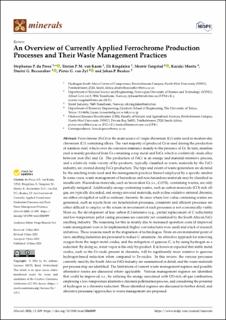| dc.description.abstract | Ferrochrome (FeCr) is the main source of virgin chromium (Cr) units used in modern-day chromium (Cr) containing alloys. The vast majority of produced Cr is used during the production of stainless steel, which owes its corrosion resistance mainly to the presence of Cr. In turn, stainless steel is mainly produced from Cr-containing scrap metal and FeCr, which is a relatively crude alloy between iron (Fe) and Cr. The production of FeCr is an energy and material-intensive process, and a relatively wide variety of by-products, typically classified as waste materials by the FeCr industry, are created during FeCr production. The type and extent of waste generation are dictated by the smelting route used and the management practices thereof employed by a specific smelter. In some cases, waste management of hazardous and non-hazardous materials may be classified as insufficient. Hazardous materials, such as hexavalent Cr, i.e., Cr(VI), -containing wastes, are only partially mitigated. Additionally, energy-containing wastes, such as carbon monoxide (CO)-rich off-gas, are typically discarded, and energy-invested materials, such as fine oxidative sintered chromite, are either stockpiled or sold as ordinary chromite. In cases where low-value containing wastes are generated, such as rejects from ore beneficiation processes, consistent and efficient processes are either difficult to employ or the return on investment of such processes is not economically viable. More so, the development of less carbon (C)-intensive (e.g., partial replacement of C reductants) and low-temperature pellet curing processes are currently not considered by the South African FeCr smelting industry. The reasoning for this is mainly due to increased operation costs (if improved waste management were to be implemented/higher cost reductants were used) and a lack of research initiatives. These reasons result in the stagnation of technologies. From an environmental point of view, smelting industries are pressured to reduce C emissions. An attractive approach for removing oxygen from the target metal oxides, and the mitigation of gaseous C, is by using hydrogen as a reductant. By doing so, water vapor is the only by-product. It is however expected that stable metal oxides, such as the Cr-oxide present in chromite, will be significantly more resistive to gaseous hydrogen-based reduction when compared to Fe-oxides. In this review, the various processes currently used by the South African FeCr industry are summarized in detail, and the waste materials per process step are identified. The limitations of current waste management regimes and possible alternative routes are discussed where applicable. Various management regimes are identified that could be improved, i.e., by utilizing the energy associated with CO-rich off-gas combustion, employing a low-temperature alternative chromite pelletization process, and considering the potential of hydrogen as a chromite reductant. These identified regimes are discussed in further detail, and alterative processes/approaches to waste management are proposed. | en_US |

